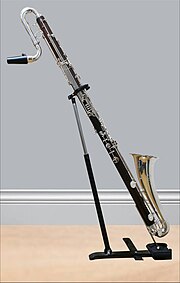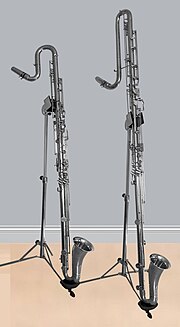 A Contra-alto clarinet with range to low E♭ (right) in comparison with an Alto clarinet with range to low C. (Buffet Crampon/Dietz) | |
| Woodwind instrument | |
|---|---|
| Classification | |
| Hornbostel–Sachs classification | (Single-reeded aerophone with keys) |
| Playing range | |
 The sounding range is G1 to B♭4. | |
| Related instruments | |





The contra-alto clarinet, E♭ contrabass clarinet, is a large clarinet pitched a perfect fifth below the B♭ bass clarinet. It is a transposing instrument in E♭ sounding an octave and a major sixth below its written pitch, between the bass clarinet and the B♭ contrabass clarinet.
The contra-alto clarinet is often used in clarinet choirs[1] and ensembles of clarinets and saxophones. It may also be present in a wind band. The repertoire for contra-alto clarinet in the symphony orchestra is limited. In ensembles it is usually used in unison with the other woodwind instruments, such as (bassoon, bass clarinet and contrabass clarinet), or it plays the lower octave in addition. [citation needed]
The contra-alto clarinet[2] is largely a development of the 2nd half of the 20th century, although there were some precursors in the 19th century:
Other makers of contra-alto clarinets have developed mainly stretched models. These include:
Today's contra-alto clarinets are mainly based on the Boehm system, although models with the German system also existed in the past.
The range of most contra-alto clarinets extends downwards to its low E♭ (concert G♭1). Some models go down to D (concert F1) or C (concert E♭1). For this the instrument must be longer and have additional keys which the player operates with the right thumb and/or little fingers (as with the basset horn). In the altissimo range, the fingerings on the contra-alto clarinet are sometimes different from those on the higher clarinets.[10]
Modern contra-alto clarinets have a double (or even triple) automatic stop key. [citation needed]
The contra-alto clarinet has a curved bell, mainly made of metal, which is necessary for sound projection. It is located in the lowest part of the instrument. On the curved clarinets ("paper clip") the bell is in the upper part of the instrument.
The instrument can be played sitting down or standing up with the help of a peg or a strap.
In orchestration, the contra-alto clarinet's playing is as fast as that of the bass clarinet. Unlike other low wind instruments (contrabassoon, tuba, ...) it can play a wide range of nuances from "fff" to "ppp" and articulations ("legato", "staccato", slap, ...). In contemporary music, composers use its ability to produce polyphonic sounds. [citation needed]
The length of the tube (without bell) ranges from about 190 centimeters for a contra-alto clarinet, which lowest written tone is E♭, and up to about 230 centimeters for an instrument down to C.
As the contra-alto clarinet is a relatively young instrument, its repertoire is limited and much smaller than that of the contrabass clarinet. It is represented in all musical styles that emerged after the end of the 19th century, from neoclassicism, New Music, jazz and contemporary music to experimental rock. [citation needed]
In the mid-1960s, pieces in which contra-alto clarinets were also used were said to be heard even from the loudspeakers of small television sets.[citation needed] The instrument was also in Hollywood: early episodes of The Twilight Zone, Star Trek [citation needed]
Given the limited written repertoire in orchestras and ensembles, contra-alto clarinets can play in unison with other low wind instruments or provide a foundation in the lower octave to the woodwinds playing higher (organ pedal effect).
Parts for baritone saxophone in E♭ for wind bands can also be used for contra-alto clarinet. There are also transcriptions and transpositions of pieces written for low instruments in C, such as double bass, bass guitar, bassoon, and tuba.
In the publishing houses, part of the repertoire of the contra-alto clarinet is shared with that of the contrabass clarinet.
Americans became aware of the importance of instrumentation during the 20th century to give instruments such as the contra-alto clarinet a place in the brass band (in English military band or concert band).[13]
There are arrangements for this instrument drawn from the repertoire for other low wind instruments (tuba, bassoon, ...).
Recordings in which the contra-alto clarinettist appears as a soloist or chamber musician are extremely rare. A compact disc of duets for contra-alto and contrabass clarinets was recorded in 2018.[14]